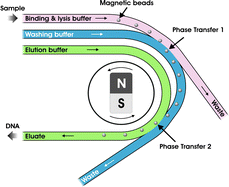Continuous microfluidic DNAextraction using phase-transfer magnetophoresis
Abstract
This paper reports a novel microfluidic-chip based platform using “phase-transfer

* Corresponding authors
a
HSG-IMIT, Wilhelm-Schickard-Strasse 10, Villingen-Schwenningen, Germany
E-mail:
marc.karle@hsg-imit.de
Fax: +49-761-203-7322
Tel: +49-761-203-7329
b Laboratory for MEMS Applications, Department of Microsystems Engineering - IMTEK, University of Freiburg, Georges-Köhler-Allee 106, Freiburg, Germany
c University Medical Centre Freiburg, Institute of Forensic Medicine, Albertstr. 9, Freiburg, Germany
d Centre for Biological Signalling Studies (bioss), University of Freiburg, Germany
This paper reports a novel microfluidic-chip based platform using “phase-transfer

 Please wait while we load your content...
Something went wrong. Try again?
Please wait while we load your content...
Something went wrong. Try again?
M. Karle, J. Miwa, G. Czilwik, V. Auwärter, G. Roth, R. Zengerle and F. von Stetten, Lab Chip, 2010, 10, 3284 DOI: 10.1039/C0LC00129E
To request permission to reproduce material from this article, please go to the Copyright Clearance Center request page.
If you are an author contributing to an RSC publication, you do not need to request permission provided correct acknowledgement is given.
If you are the author of this article, you do not need to request permission to reproduce figures and diagrams provided correct acknowledgement is given. If you want to reproduce the whole article in a third-party publication (excluding your thesis/dissertation for which permission is not required) please go to the Copyright Clearance Center request page.
Read more about how to correctly acknowledge RSC content.
 Fetching data from CrossRef.
Fetching data from CrossRef.
This may take some time to load.
Loading related content
